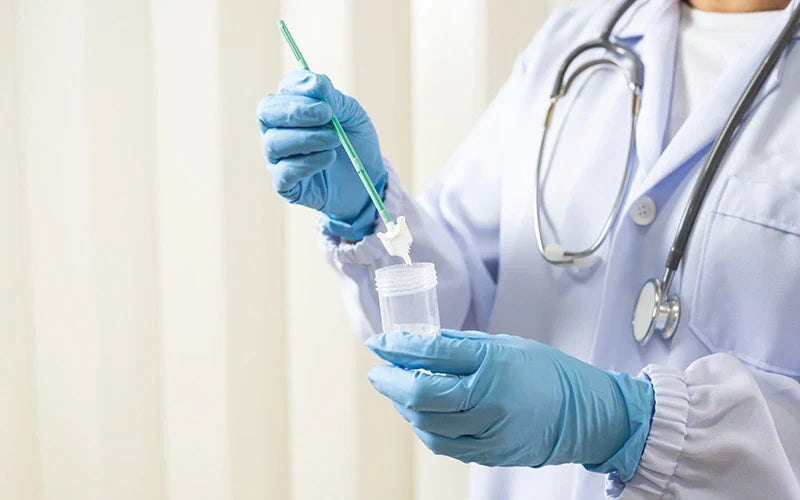Keeping track of our health is important throughout menopause. One regular screening that is recommended for women is vaginal cytology.
What is vaginal cytology?
Also known as cervical screening, cervical cytology, or pap smear (after Dr. George Papanicolaou, creator of the test). The purpose of the test is to check the condition of the cervix. It can identify changes which could indicate infection or cells which could become cancerous. (1,2)
How is cervical cytology performed?
The vaginal cytology is a quick, approximately 10-minute test performed at your GP clinic. The test involves: (1,3)
- Undressing from the waist down.
- Lying down on a bed
- The gynecologist or nurse will insert a speculum into the vagina. This instrument helps to visualise the cervix.
- With a small, soft brush, they will proceed to scrape the cervix to obtain a selection of cells. You may feel slight discomfort during the process.
- The cells are then placed in a glass container and sent to the laboratory.
Recommendations prior to vaginal cytology
There are a couple of recommendations before having your cervical screening: (2,3)
- Avoid vaginal douching.
- Do not use tampons.
- Urinate before the procedure.
- Do not schedule this test if you are menstruating. If you are no longer menstruating, you can have this test at any time.
In addition, you should inform your doctor if you have had a previous diagnosis of HPV (Human Papilloma Virus), suspected vaginitis, have pelvic pain, have a bad vaginal odour. Also, if you think you may be pregnant or have had a hysterectomy.
When is it advisable?
Specialists recommend that every woman should have a Pap test from the age of 25. The recommended frequency is: (4)
- Every 3 years, from the age of 25 to 49.
- Then every 5 years from the age of 50 to 64.
- From the age of 65 onwards. Here you should only repeat it if any of the last 3 tests were abnormal.
You may need to repeat the test more frequently if the results are abnormal, if there is suspicion of sexually transmitted diseases or vaginal infections, or if there is abnormal vaginal bleeding (2,4).
This procedure is optional, but it is important to note that it is key to preventing the development of cervical cancer. Remember that cervical cancer progresses slowly and, if you catch it early, you have a very high chance of being successfully treated (2) .

Keys to interpreting the results
It is important that a specialist read the cytology results; they may contain technical language. However, the possible results are: (5)
- Normal cytology.
- HPV found, but no abnormal cells. You must repeat the test every year for three years.
- HPV found with abnormal cells. You will probably be referred for a colposcopy or cervical biopsy.
What diseases does the vaginal cytology detect?
It can detect the presence of HPV and changes in cervical cells that could develop into cancer (1,5). However, it can also identify other sexually transmitted infections, vaginal infections, or yeast infections. (2)
Common myths and truths about the test
Finally, let us look at some common myths and truths about this test (1,2,3,4,5):
- It evaluates the female reproductive system. A vaginal cytology only evaluates the cervix; to see other female organs, a pelvic ultrasound, CT scans, X-rays, etc. may be necessary.
- It causes a lot of pain. In general, it is an uncomfortable but not painful test, the pain could indicate an infection or other problem.
- It cannot be performed on virgin women. Specialists recommend having a Pap smear, even if the woman has not had sexual intercourse.
- Causes bleeding. It is possible to experience slight bleeding after the test.
- You should have it done for life. Women over 65 should only have it done if any of their last 3 tests were abnormal.
- Women who have undergone a total hysterectomy should not have the test. In a total hysterectomy, the uterus and cervix are removed from the body, so this test is no longer necessary.
- Vaginal cytology and uterine curettage should not be confused as they are two gynecological procedures with different purposes.
- It can help detect vaginal infections, but not vaginismus.
In conclusion, vaginal cytology is a simple and quick test that can help prevent cervical cancer. Although specialists recommend that all women undergo this test every 3 to 5 years, it is entirely elective.
References
- National Health System – NHS. What is cervical screening?
- MedlinePlus. Pap test.
- National Health System – NHS. NHS cervical screening helping you decide.
- National Health System – NHS. When you will be invited.
- National Health System – NHS. Your results
. 2020 . Available from: https://www.nhs.uk/conditions/cervical-screening/your-results/
You May Also Like

JOIN US AND GET 10% OFF
Sign up to our newsletter to access free resources, advice and support.















